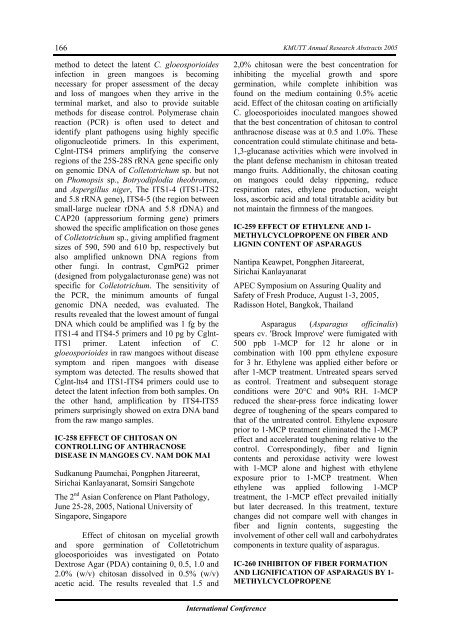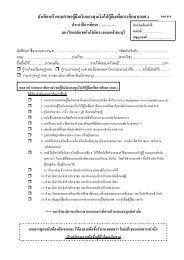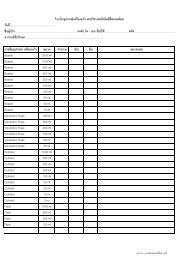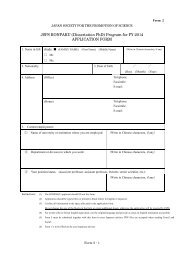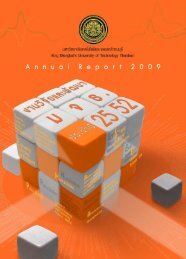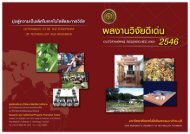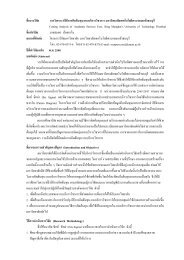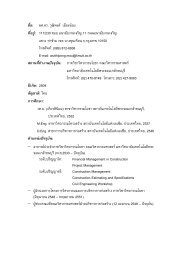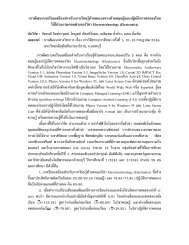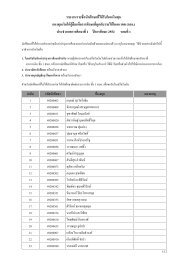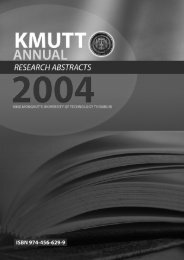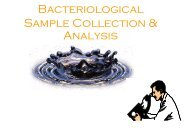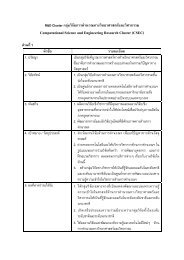You also want an ePaper? Increase the reach of your titles
YUMPU automatically turns print PDFs into web optimized ePapers that Google loves.
166<br />
method to detect the latent C. gloeosporioides<br />
infection in green mangoes is becoming<br />
necessary for proper assessment of the decay<br />
and loss of mangoes when they arrive in the<br />
terminal market, and also to provide suitable<br />
methods for disease control. Polymerase chain<br />
reaction (PCR) is often used to detect and<br />
identify plant pathogens using highly specific<br />
oligonucleotide primers. In this experiment,<br />
Cglnt-ITS4 primers amplifying the conserve<br />
regions of the 25S-28S rRNA gene specific only<br />
on genomic DNA of Colletotrichum sp. but not<br />
on Phomopsis sp., Botryodiplodia theobromea,<br />
and Aspergillus niger, The ITS1-4 (ITS1-ITS2<br />
and 5.8 rRNA gene), ITS4-5 (the region between<br />
small-large nuclear rDNA and 5.8 rDNA) and<br />
CAP20 (appressorium forming gene) primers<br />
showed the specific amplification on those genes<br />
of Colletotrichum sp., giving amplified fragment<br />
sizes of 590, 590 and 610 bp, respectively but<br />
also amplified unknown DNA regions from<br />
other fungi. In contrast, CgmPG2 primer<br />
(designed from polygalacturonase gene) was not<br />
specific for Colletotrichum. The sensitivity of<br />
the PCR, the minimum amounts of fungal<br />
genomic DNA needed, was evaluated. The<br />
results revealed that the lowest amount of fungal<br />
DNA which could be amplified was 1 fg by the<br />
ITS1-4 and ITS4-5 primers and 10 pg by Cglnt-<br />
ITS1 primer. Latent infection of C.<br />
gloeosporioides in raw mangoes without disease<br />
symptom and ripen mangoes with disease<br />
symptom was detected. The results showed that<br />
Cglnt-lts4 and ITS1-ITS4 primers could use to<br />
detect the latent infection from both samples. On<br />
the other hand, amplification by ITS4-ITS5<br />
primers surprisingly showed on extra DNA band<br />
from the raw mango samples.<br />
IC-258 EFFECT OF CHITOSAN ON<br />
CONTROLLING OF ANTHRACNOSE<br />
DISEASE IN MANGOES CV. NAM DOK MAI<br />
Sudkanung Paumchai, Pongphen Jitareerat,<br />
Sirichai Kanlayanarat, Somsiri Sangchote<br />
The 2 nd Asian Conference on Plant Pathology,<br />
June 25-28, 2005, National University of<br />
Singapore, Singapore<br />
Effect of chitosan on mycelial growth<br />
and spore germination of Colletotrichum<br />
gloeosporioides was investigated on Potato<br />
Dextrose Agar (PDA) containing 0, 0.5, 1.0 and<br />
2.0% (w/v) chitosan dissolved in 0.5% (w/v)<br />
acetic acid. The results revealed that 1.5 and<br />
KMUTT Annual Research Abstracts 2005<br />
2,0% chitosan were the best concentration for<br />
inhibiting the mycelial growth and spore<br />
germination, while complete inhibition was<br />
found on the medium containing 0.5% acetic<br />
acid. Effect of the chitosan coating on artificially<br />
C. gloeosporioides inoculated mangoes showed<br />
that the best concentration of chitosan to control<br />
anthracnose disease was at 0.5 and 1.0%. These<br />
concentration could stimulate chitinase and beta-<br />
1,3-glucanase activities which were involved in<br />
the plant defense mechanism in chitosan treated<br />
mango fruits. Additionally, the chitosan coating<br />
on mangoes could delay rippening, reduce<br />
respiration rates, ethylene production, weight<br />
loss, ascorbic acid and total titratable acidity but<br />
not maintain the firmness of the mangoes.<br />
IC-259 EFFECT OF ETHYLENE AND 1-<br />
METHYLCYCLOPROPENE ON FIBER AND<br />
LIGNIN CONTENT OF ASPARAGUS<br />
Nantipa Keawpet, Pongphen Jitareerat,<br />
Sirichai Kanlayanarat<br />
APEC Symposium on Assuring Quality and<br />
Safety of Fresh Produce, August 1-3, 2005,<br />
Radisson Hotel, Bangkok, Thailand<br />
Asparagus (Asparagus officinalis)<br />
spears cv. 'Brock Improve' were fumigated with<br />
500 ppb 1-MCP for 12 hr alone or in<br />
combination with 100 ppm ethylene exposure<br />
for 3 hr. Ethylene was applied either before or<br />
after 1-MCP treatment. Untreated spears served<br />
as control. Treatment and subsequent storage<br />
conditions were 20°C and 90% RH. 1-MCP<br />
reduced the shear-press force indicating lower<br />
degree of toughening of the spears compared to<br />
that of the untreated control. Ethylene exposure<br />
prior to 1-MCP treatment eliminated the 1-MCP<br />
effect and accelerated toughening relative to the<br />
control. Correspondingly, fiber and Iignin<br />
contents and peroxidase activity were lowest<br />
with 1-MCP alone and highest with ethylene<br />
exposure prior to 1-MCP treatment. When<br />
ethylene was applied following 1-MCP<br />
treatment, the 1-MCP effect prevailed initially<br />
but later decreased. In this treatment, texture<br />
changes did not compare well with changes in<br />
fiber and Iignin contents, suggesting the<br />
involvement of other cell wall and carbohydrates<br />
components in texture quality of asparagus.<br />
IC-260 INHIBITON OF FIBER FORMATION<br />
AND LIGNIFICATION OF ASPARAGUS BY 1-<br />
METHYLCYCLOPROPENE<br />
International Conference


